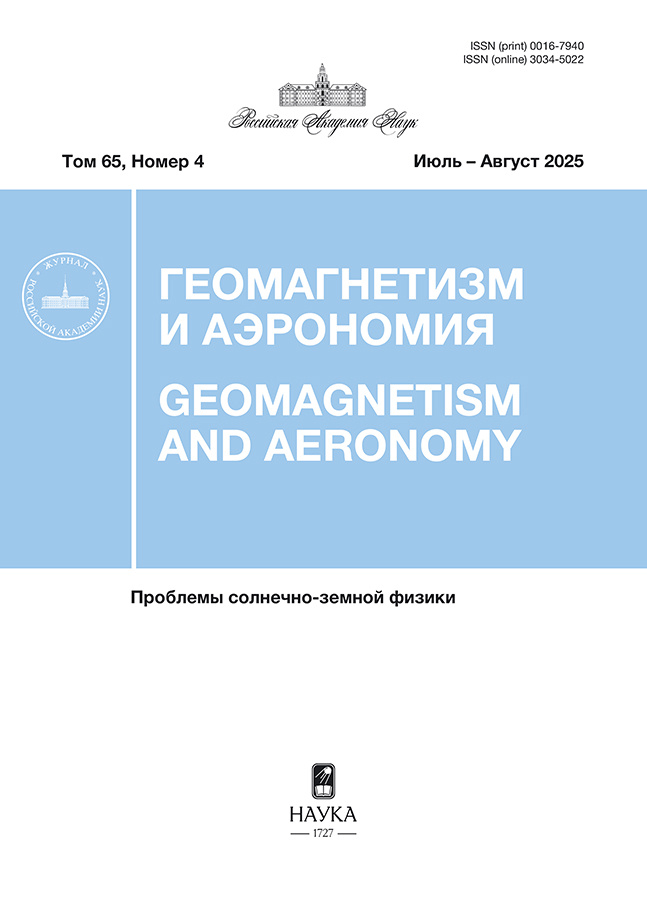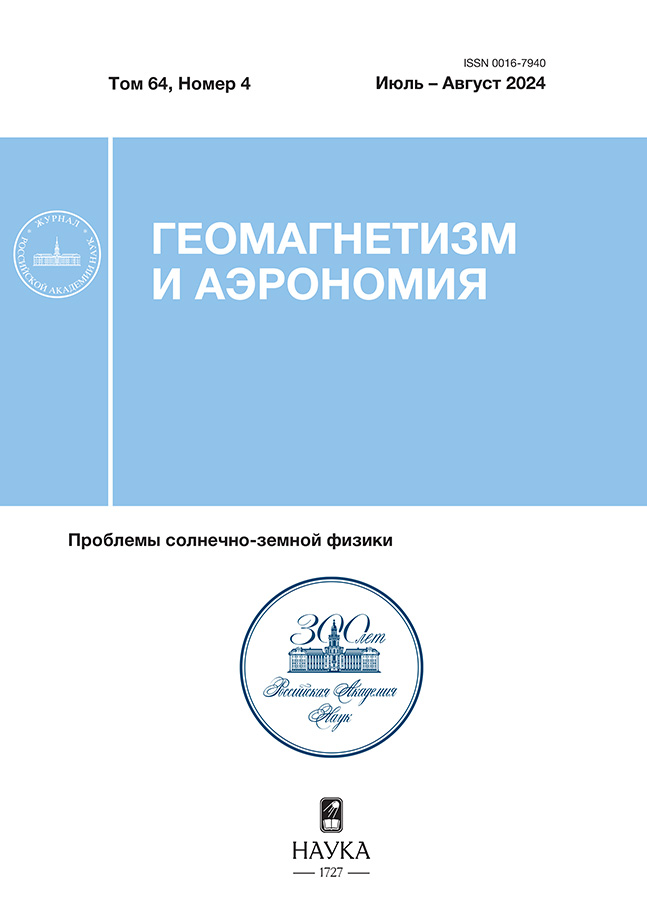Kinematics of flare ribbons during eruption of solar prominences
- Authors: Filippov B.P.1
-
Affiliations:
- Pushkov Institute of Terrestrial Magnetism, Ionosphere, and Radio Wave Propagation, Russian Academy of Sciences
- Issue: Vol 64, No 4 (2024)
- Pages: 456-464
- Section: Articles
- URL: https://permmedjournal.ru/0016-7940/article/view/650916
- DOI: https://doi.org/10.31857/S0016794024040012
- EDN: https://elibrary.ru/RTWBNP
- ID: 650916
Cite item
Abstract
Flare ribbons formed in solar two-ribbon flares after eruptions of prominences diverge in opposite directions from the polarity inversion line of the photospheric longitudinal magnetic field, sharply slowing down with time and distance from this line. Examples of such events are given and the kinematics of flare ribbons is demonstrated. A comparison of the position of the ribbons with the distribution of the photospheric magnetic field shows that the separation of the ribbons slows down when they enter a region of a strong longitudinal field. A simple model of prominence eruption illustrates the kinematic features of the motion of the ribbons and the relation to the sources of the coronal magnetic field in the photosphere.
About the authors
B. P. Filippov
Pushkov Institute of Terrestrial Magnetism, Ionosphere, and Radio Wave Propagation, Russian Academy of Sciences
Author for correspondence.
Email: bfilip@izmiran.ru
Russian Federation, Moscow, Troitsk
References
- Прист Э., Форбс Т. Магнитное пересоединение. Пер. с англ. ред. В.Д. Кузнецов, А.Г. Франк. М: Физматлит, 592 с. 2005.
- Carmichael H. A process for flares / The Physics of Solar Flares / Proceedings of the AAS-NASA Symposium. Greenbelt, MD. October 28−30, 1963. Ed. Hess W.N. SP-50 of NASA Special Publications, Washington: NASA Scientific and Technical Information Division. P. 451−456. 1964.
- Carrington R.C. Description of a singular appearance seen in the Sun on September 1, 1859 // Mon. Not. R. Astron. Soc. V. 20. P. 13−15. 1859.
- Ding M.D., Chen Q.R., Li J.P., Chen P.F. Hα and hard X-ray observations of a two-ribbon flare associated with a filament eruption // Astrophys. J. V. 598. № 1. P. 683−688. 2003. https://doi.org/10.1086/378877
- Durant C.J. Polar magnetic fields – filaments and the zero-flux contour // Solar Phys. V. 211. № 1−2. P. 83−102. 2002. https://doi.org/10.1023/A:1022501505915
- Filippov B. Electric current equilibrium in the corona // Solar Phys. V. 283. № 2. P. 401−411. 2013. https://doi.org/10.1007/s11207-013-0253-4
- Filippov B. Rising of a magnetic null point in the wake of an erupting flux rope // Mon. Not. R. Astron. Soc. V. 512. № 1. P. 1357–1364. 2022. https://doi.org/10.1093/mnras/stac575
- Fletcher L., Dennis B.R., Hudson H.S. et al. An observational overview of solar flares // Space Sci. Rev. V. 159. № 1−4. ID 19. 2011. https://doi.org/10.1007/s11214-010-9701-8
- Forbes T.G., Priest E.R. Reconnection in solar flares / Solar Terrestrial Physics: Present and Future. Eds. Butler D.M., Papadopoulous K. Greenbelt, MD: NASA Reference Publication 1120. P. 1−35. 1984.
- Forbes T.G., Lin J. What can we learn about reconnection from coronal mass ejections? // J. Atmos. Sol.-Terr. Phy. V. 62. № 16. P. 1499−1507. 2000. https://doi.org/10.1016/S1364-6826(00)00083-3
- Forbes T.G., Seaton D.B., Reeves K.K. Reconnection in the post-impulsive phase of solar flares // Astrophys. J. V. 858. № 2. ID 70. 2018. https://doi.org/10.3847/1538-4357/aabad4
- Hinterreiter J., Veronig A.M., Thalmann J.K., Tschernitz J., Pötzi W. Statistical properties of ribbon evolution and reconnection electric fields in eruptive and confined flares // Solar Phys. V. 293. № 3. ID 38. 2018. https://doi.org/10.1007/s11207-018-1253-1
- Hirayama T. Theoretical model of flares and prominences. I: Evaporating flare model // Solar Phys. V. 34. № 2. P. 323−338. 1974. https://doi.org/10.1007/BF00153671
- Kopp R.A., Pneuman G.W. Magnetic reconnection in the corona and the loop prominence phenomenon // Solar Phys. V. 50. № 1. P. 85−98. 1976. https://doi.org/10.1007/BF00206193
- Kuperus M., Raadu M.A. The support of prominences formed in neutral sheets // Astron. Astrophys. V. 31. P. 189−193. 1974.
- Lemen J.R., Title A.M., Akin D.J., et al. The Atmospheric Imaging Assembly (AIA) on the Solar Dynamics Observatory (SDO) // Solar Phys. V. 275. № 1−2. P. 17−40. 2012. https://doi.org/10.1007/s11207-011-9776-8
- Li L., Zhang J. On the brightening propagation of post-flare loops observed by TRACE // Astrophys. J. V. 690. № 1. P. 347−357. 2009. https://doi.org/10.1088/0004-637X/690/1/347
- Lin J., Forbes T.G., Isenberg P.A., Démoulin P. The effect of curvature on flux-rope models of coronal mass ejections // Astrophys. J. V. 504. № 2. P. 1006−1019. 1998. https://doi.org/10.1086/306108
- Lin J., Soon W., Baliunas S.L. Theories of solar eruptions: a review // New Astron. Rev. V. 47. № 2. P. 53−84. 2003. https://doi.org/10.1016/S1387-6473(02)00271-3
- Martin S.F. Conditions for the formation and maintenance of filaments (invited review) // Solar Phys. V. 182. № 1. P. 107−137. 1998. https://doi.org/10.1023/A:1005026814076
- McIntosh P.S. Solar magnetic fields derived from hydrogen alpha filtergrams // Rev. Geophys. Space Phys. V. 10. № 3. P. 837−846. 1972. https://doi.org/10.1029/RG010i003p00837
- Priest E.R., Forbes T.G. Magnetic field evolution during prominence eruptions and two-ribbon flares // Solar Phys. V. 126. № 2. P. 319−350. 1990. https://doi.org/10.1007/BF00153054
- Priest E.R., Forbes T.G. The magnetic nature of solar flares // Astron. Astrophys. Rev. V. 10. № 4. P. 313−377. 2002. https://doi.org/10.1007/s001590100013
- Qiu J., Lee J., Gary D.E., Wang H. Motion of flare footpoint emission and inferred electric field in reconnecting current sheets // Astrophys. J. V. 565. № 2. P. 1335−1347. 2002. https://doi.org/10.1086/324706
- Qiu J., Wang H., Cheng C.Z., Gary, D.E. Magnetic reconnection and mass acceleration in flare–coronal mass ejection events // Astrophys. J. V. 604. № 2. P. 900−905. 2004. https://doi.org/10.1086/382122
- Schou J., Scherrer P.H., Bush R.I. et al. Design and ground calibration of the Helioseismic and Magnetic Imager (HMI) instrument on the Solar Dynamics Observatory (SDO) // Solar Phys. V. 275. № 1–2. P. 229–259. 2012. https://doi.org/10.1007/s11207-011-9842-2
- Snodgrass H.B., Kress J.M., Wilson P.R. Observations of the polar magnetic fields during the polarity reversals of cycle 22 // Solar Phys. V. 191. № 1. P. 1−19. 2000. https://doi.org/10.1023/A:1005279508869
- Sterling A.C., Moore R.L. Slow-rise and fast-rise phases of an erupting solar filament, and flare emission onset // Astrophys. J. V. 630. № 2. P. 1148−1159. 2005. https://doi.org/10.1086/432044
- Sturrock P.A. Model of the high-energy phase of solar flares // Nature. V. 211. № 5050. P. 695−697. 1966. https://doi.org/10.1038/211695a0
- Švestka Z. On the varieties of solar flares / The Lower Atmosphere of Solar Flares. Proceedings of the Solar Maximum Mission Symposium. Sunspot, NM, August 20−24, 1985. Eds. Neidig D.F., Machado M.E. Sunspot, NM: National Solar Observatory. P. 332–355. 1986.
- Van Tend W., Kuperus M. The development of coronal electric current system in active regions and their relation to filaments and flares // Solar Phys. V. 59. № 1. P. 115–127. 1978. https://doi.org/10.1007/BF00154935
- Wang H., Qiu J., Jing J., Zhang H. Study of ribbon separation of a flare associated with a quiescent filament eruption // Astrophys. J. V. 593. № 1. P. 564−570. 2003. https://doi.org/10.1086/376360
- Zhang Q.M., Yang S.H., Li T., Hou Y.J., Li Y. Fast degradation of the circular flare ribbon on 2014 August 24 // Astron. Astrophys. V. 636. ID L11. 2020. https://doi.org/10.1051/0004-6361/202038072
Supplementary files











